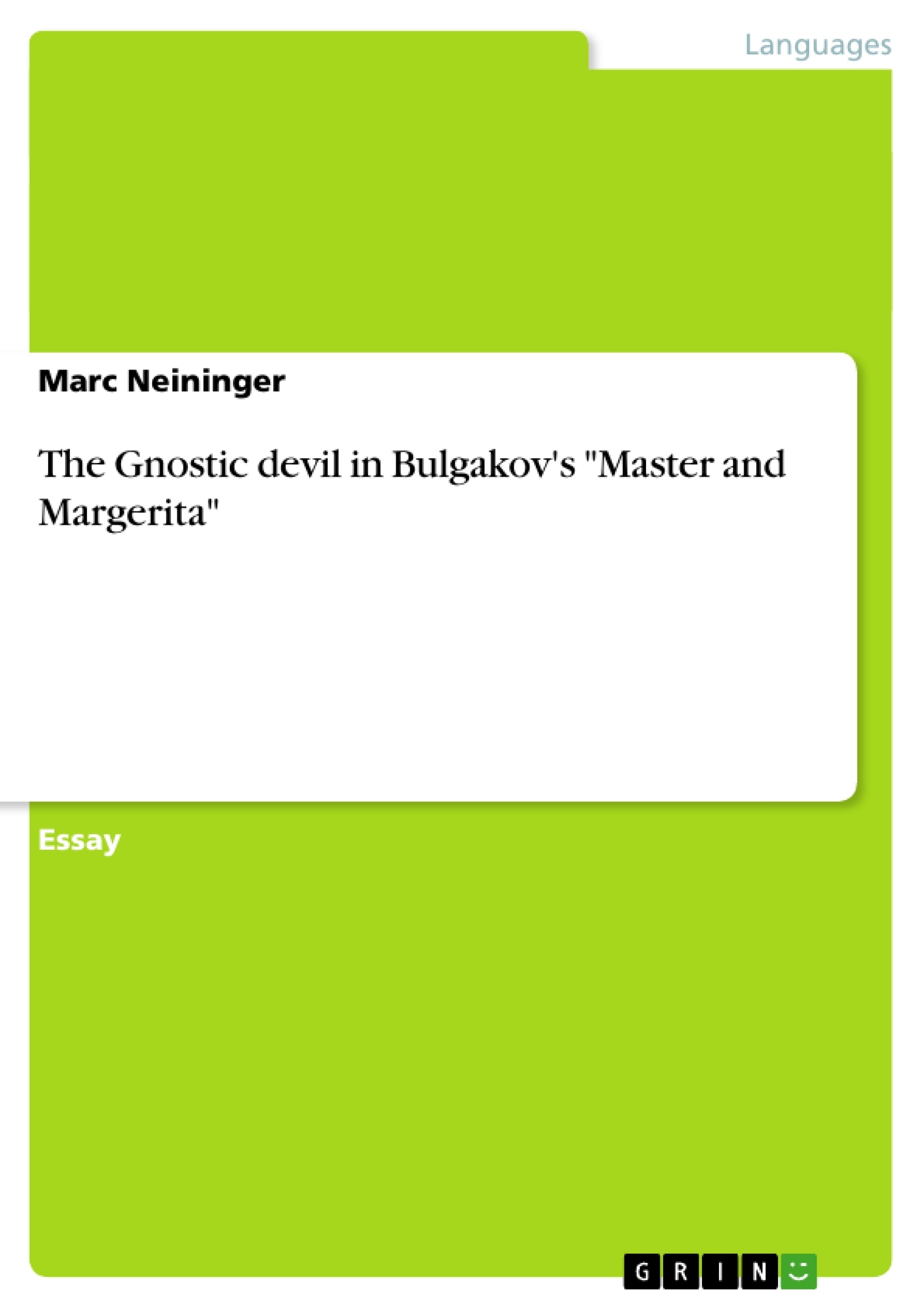The essay is written in english. It is a comparative study of the devil figure in Goethe's "Faust" and the presentation of the devil in the bible. The focus lies on on Bulgakov's devil figuration, however. The essay also deals with the Gnostic aspects in "Master and Margarita". Most of the quoted literature is available in the MLA database.
Inhaltsverzeichnis (Table of Contents)
- The Gnostic devil in The Master and Margarita
- Bulgakov's Yeshua
- Bulgakov's Satan Figure
Zielsetzung und Themenschwerpunkte (Objectives and Key Themes)
This essay analyzes the complex characterizations of Yeshua and Woland in Mikhail Bulgakov's The Master and Margarita, exploring their relationship to biblical and literary traditions. It examines how Bulgakov reinvents these figures, departing from traditional representations and creating nuanced characters within the novel's multifaceted narrative structure.
- Reinterpretation of Biblical Figures
- The Multi-Layered Narrative of The Master and Margarita
- The Nature of Good and Evil
- The Role of Myth and Reality
- Bulgakov's critique of Soviet Society
Zusammenfassung der Kapitel (Chapter Summaries)
The Gnostic devil in The Master and Margarita: This chapter introduces the complexity of Bulgakov's novel, highlighting the interwoven plots, mythical framework incorporating biblical and Christian traditions, and satirical portrayal of Soviet society. The author points out the inherent confusion arising from the obscure interrelations between the Moscow chapters, the Yershalaim chapters, and the Master's novel. The chapter establishes the need for a deep understanding of various sources, including Faust and the Bible, as well as the historical context of 1930s Soviet Moscow and Bulgakov's personal background, to fully grasp the novel's meaning. The chapter concludes by emphasizing Bulgakov's reinvention of borrowed characters and elements, significantly contributing to their complexity.
Bulgakov's Yeshua: This section delves into Bulgakov's portrayal of Yeshua, contrasting him with the traditional image of Jesus Christ. Bulgakov's Yeshua lacks supernatural powers and is presented as a human philosopher with a profound belief in the inherent goodness of humanity. The essay examines Levi Matvei's role in mythologizing Yeshua, highlighting how his writings shape the later gospels and the enduring image of Jesus. The analysis contrasts Yeshua's human qualities—his fear of death, his naivety—with the traditional depiction of Jesus, emphasizing the subversive nature of Bulgakov's reimagining. The chapter explores Yeshua's eventual attainment of enlightenment, not through faith in God, but through his unwavering belief in the goodness of all people, linking this to the concept of a "divine spark" within humanity, representing a form of gnosis.
Bulgakov's Satan Figure: This chapter analyzes Bulgakov's portrayal of Woland, highlighting the character's complexity and multi-referentiality. The essay explores Woland's relationship to both the traditional Christian devil and Goethe's Mephistopheles, emphasizing the ambiguity of his nature. The author argues that Woland represents the spiritual realm on Earth, acting as an agent of God rather than a simple antagonist. By tracing the evolution of the concept of Satan from the Old Testament, where it signifies an adversary rather than an opponent of God, the chapter demonstrates that Woland's role transcends simple evil, instead embodying a more complex and multifaceted representation of the spiritual realm within the earthly context of Bulgakov's narrative.
Schlüsselwörter (Keywords)
The Master and Margarita, Mikhail Bulgakov, Yeshua, Woland, Satan, Jesus Christ, myth, reality, Soviet society, Gnosticism, reinterpretation, good and evil, literary tradition, biblical tradition, Faust, Mephistopheles.
Frequently Asked Questions: Analysis of Mikhail Bulgakov's *The Master and Margarita*
What is the purpose of this document?
This document provides a comprehensive preview of an essay analyzing the characters of Yeshua and Woland in Mikhail Bulgakov's The Master and Margarita. It includes a table of contents, objectives and key themes, chapter summaries, and keywords. The information is presented in a structured format suitable for academic use and thematic analysis.
What are the key themes explored in the essay?
The essay explores several key themes, including the reinterpretation of biblical figures, the multi-layered narrative structure of The Master and Margarita, the nature of good and evil, the interplay of myth and reality, and Bulgakov's critique of Soviet society.
What are the main chapters and their focus?
The essay is divided into three main chapters: "The Gnostic devil in The Master and Margarita," which introduces the novel's complexities and the interplay of various sources; "Bulgakov's Yeshua," which analyzes Bulgakov's portrayal of Yeshua in contrast to the traditional image of Jesus Christ; and "Bulgakov's Satan Figure," which examines the multifaceted nature of Woland and his relationship to both traditional and literary representations of Satan.
How does the essay analyze Bulgakov's portrayal of Yeshua?
The essay contrasts Bulgakov's Yeshua with the traditional image of Jesus Christ, highlighting Yeshua's lack of supernatural powers and his portrayal as a human philosopher. It examines Yeshua's human qualities and his eventual attainment of enlightenment through his belief in the inherent goodness of humanity, connecting this to the concept of Gnosticism.
How does the essay analyze Bulgakov's portrayal of Woland?
The essay analyzes Woland's complexity and multi-referentiality, exploring his relationship to both the traditional Christian devil and Goethe's Mephistopheles. It argues that Woland represents the spiritual realm on Earth, acting as an agent of God rather than a simple antagonist, and that his role transcends simple evil.
What sources are referenced in the essay?
The essay draws upon various sources, including the Bible, Goethe's Faust, and historical context of 1930s Soviet Moscow. It also considers Bulgakov's personal background to understand the novel's meaning and the author's unique reimagining of borrowed characters and elements.
What are the keywords associated with this analysis?
Keywords include: The Master and Margarita, Mikhail Bulgakov, Yeshua, Woland, Satan, Jesus Christ, myth, reality, Soviet society, Gnosticism, reinterpretation, good and evil, literary tradition, biblical tradition, Faust, and Mephistopheles.
- Quote paper
- Marc Neininger (Author), 2004, The Gnostic devil in Bulgakov's "Master and Margerita", Munich, GRIN Verlag, https://www.grin.com/document/39240



